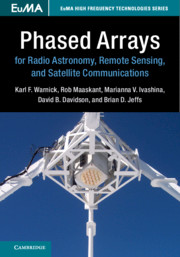Book contents
- Frontmatter
- Contents
- Preface
- Acknowledgements
- Notation and Units
- 1 Phased Arrays for High-sensitivity Receiver Applications
- 2 Active Antenna Receivers
- 3 Antenna Examples
- 4 Transmitting Arrays, Network Analysis, and Pattern Overlap Integrals
- 5 Array Receiver Theory and Modeling
- 6 Figures of Merit for Active Receiving Arrays
- 7 Design and Optimization of Phased Array Antennas
- 8 Numerical Modeling of Phased Array Antennas
- 9 Analog Front End, Array Elements, and Receiver Electronics
- 10 Array Signal Processing, Calibration, and Beamforming
- 11 Interferometric Arrays and Synthesis Imaging
- 12 Real Time Digital Signal Processing
- Index
- References
11 - Interferometric Arrays and Synthesis Imaging
Published online by Cambridge University Press: 14 July 2018
- Frontmatter
- Contents
- Preface
- Acknowledgements
- Notation and Units
- 1 Phased Arrays for High-sensitivity Receiver Applications
- 2 Active Antenna Receivers
- 3 Antenna Examples
- 4 Transmitting Arrays, Network Analysis, and Pattern Overlap Integrals
- 5 Array Receiver Theory and Modeling
- 6 Figures of Merit for Active Receiving Arrays
- 7 Design and Optimization of Phased Array Antennas
- 8 Numerical Modeling of Phased Array Antennas
- 9 Analog Front End, Array Elements, and Receiver Electronics
- 10 Array Signal Processing, Calibration, and Beamforming
- 11 Interferometric Arrays and Synthesis Imaging
- 12 Real Time Digital Signal Processing
- Index
- References
Summary
Introduction
Up to now, the focus of this book has been on phased arrays, or beamformers. For radio astronomy, another type of array, namely interferometers or correlator arrays or synthesis arrays are very important. For mapping applications (such as sky surveys), interferometers gather information more efficiently than phased arrays [1, Sec. 5.3], which is why many of the existing and proposed array-based astronomical instruments described earlier in this book are in fact hierarchical arrays. Each dish may have a PAF array feed or each station may consist of an aperture array, and the dishes and stations are in turn part of a sparse synthesis array which may extend over very long distances – including into space in VLBI.
The key difference between a phased array and a correlator array is the method by which beam-scanning is accomplished. In the former, a phased array points the narrow beam formed in a particular direction, which then must be scanned over the field of interest, whereas at any instant, a correlator array responds simultaneously to the whole field of view of the individual antennas (i.e., dishes or stations), also known as the primary beam. (Here, we assume that the phased array forms only one beam simultaneously.) Interferometry accomplishes this by Fourier transforming the cross-correlation products of each receiver's voltages with every other. The complex exponentials in the Fourier integral can be seen as simultaneously weighting these correlations with appropriate phase variations, thus effectively scanning the beam with one pointing. Modern correlation arrays also usually compute the self-products, which also permit classical beamforming to be accomplished.
Modern sparse synthesis array calibration relies on regular on-the-fly measurements of known calibrator sources, and also uses a method known as self-calibration; work is presently in progress on methods suitable for even higher dynamic range and incorporating more subtle instrumentation effects. In this chapter, we review these methods, observing that calibration and imaging for compact arrays and these sparse synthesis arrays are somewhat different procedures. The basics of sparse synthesis array calibration and interferometric imaging have been known for decades, but new systems, in particular aperture arrays, have thrown up new challenges in this field.
Information
- Type
- Chapter
- Information
- Publisher: Cambridge University PressPrint publication year: 2018
